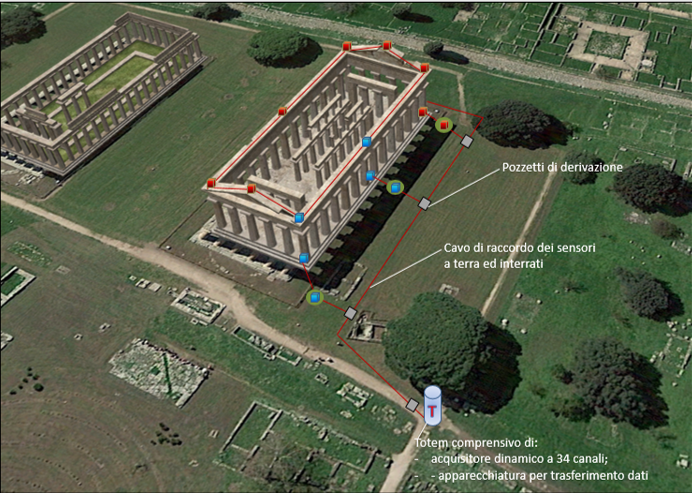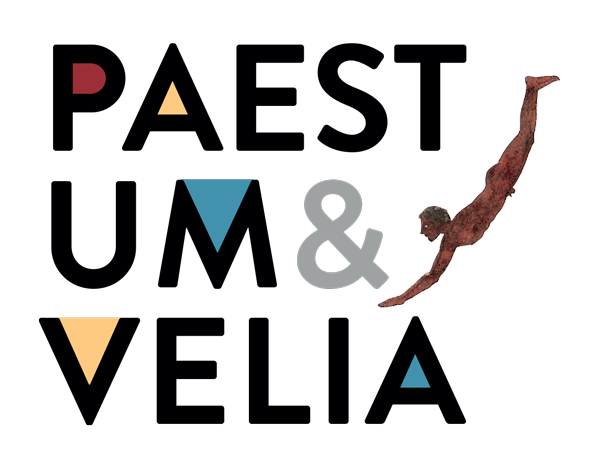PAESTUM: ONLINE SEISMIC MONITORING OF THE TEMPLE OF NEPTUNE THE TEMPLE EXCAVATIONS SHED LIGHT ON THE HISTORY OF ITS CONSTRUCTION

Real-time monitoring and preventive conservation
Since March 2021, the best-preserved temple in Magna Graecia has undergone continuous seismic monitoring thanks to a collaborative partnership between the Archaeological Park of Paestum and Velia and the Department of Civil Engineering of the University of Salerno. Fourteen measuring points, created using state-of-the-art sensors and developed as part of the research on gravitational waves, have been positioned on the upper parts of the building dating to the fifth century BC and placed underground in order to measure even the slightest movements of the ancient structure in real time. The accelerometers are so precise that they can record not just seismic activity but also the impact of traffic and even the wind on the temple. By being recorded systematically, the data will help to formulate a dynamic behavioural model of the building and will prove crucial to tracking structural changes, invisible to the naked eye, which might pose a risk.
“It’s a successful combination of applied research and conservation – observes Professor Luigi Petti of the University of Salerno – which employs highly innovative technologies and sensors, developed by Professor Fabrizio Barone for applications in the fields of seismology and geophysics, bringing together expertise from many scientific sectors such as archaeology, architecture, geology and structural engineering. These activities are part of a wider-ranging research project, involving “La Sapienza” University in Rome and the University of Kassel in Germany. A collaborative partnership has also begun with ISPRA (The Italian Institute for Environmental Protection and Research) to conduct monitoring activities at cultural heritage sites”.
The monitoring system was designed by the architect Antonella Manzo, formerly director of the UNESCO office of the Archaeological Park, in conjunction with Professor Luigi Petti of the Department of Civil Engineering at the University of Salerno. The work was directed by the architect Luigi Di Muccio of the Soprintendenza ABAP (the Superintendency for Archaeology, Fine Arts and Landscape) of Caserta and Benevento.

The data published online on the Park website
The data centre of the University of Salerno, in conjunction with the Archaeological Park, will enable access to the data to research institutes and universities worldwide, upon entering into an inexpensive standing agreement. Meanwhile, some of the data is freely accessible in real time on the website of the Archaeological Park Paestum e Velia:
http://museopaestum.cultura.gov.it/monitoraggio-sismico-del-tempio-di-nettuno.
“In this way – observes Maria Boffa, head of communications at the Park – it will be possible to access the site from anywhere in the world to follow the dynamic behaviour of the Temple of Neptune in real time. Obviously, the data uploaded to the site will be in a fairly rough and partial form and to gain access to the complete dataset, it will be necessary to make a formal request. To get a more precise idea of what we are talking about, have a trial run by watching the video footage of the oscillation of the monument live when the high-speed Frecciarossa train passes, or when the weather at Paestum is bad. This is how we hope to raise awareness among the public about a field of research which has long been the sole preserve of experts and to show how technology can help in the conservation of cultural heritage”.

Survey developed in the context of the joint PAEVE-DICIV (UNISA) research activities with the support of profs. Luigi Petti and Salvatore Barba, of the Arch. Alfredo Balasco and dr. Salvatore Ciro Nappo.
News about excavations along the foundations
In order to position the sensors underground, new excavations were carried out along the foundations of the monument. The excavations, which were coordinated by the archaeologists Daniele Rossetti and Francesco Scelza, threw up several surprises. “It may seem odd – underlines the director of the Archaeological Park, Gabriel Zuchtriegel – but they are the first properly controlled and recorded excavations to be carried out on the Temple of Neptune, one of the most famous Doric monuments of the ancient world. Sometimes the most famous monuments – which seem so well-known even though this may not actually be the case – still hide surprises. In our case, it is chiefly the chronology that we were able to clarify thanks to the fortune of finding intact stratigraphy which still preserves the history of the construction work on the temple. In the past, Dieter Mertens suggested that on the basis of several details of the podium the temple had originally had a peripteral layout of 8 x 19 columns before being redesigned in a more ‘modern’ form with 6 x 14 columns. Our excavations have demonstrated that all the foundations date back to the late-archaic period, about fifty years before the completion of the project in around 460 BC. Like the great medieval cathedrals, we have to imagine a building site that went on for several generations, with afterthoughts, adjustments and changes during the construction work. Moreover, the excavation has enabled us to reconstruct the way the building of the temple re-shaped the surrounding landscape. Before beginning the construction, the area where the temple would eventually be built had been levelled off, without significantly lowering the level below ground level. The foundations were placed on top of a thin layer of sand, found in all four of the excavations conducted along the foundations, and therefore stood almost completely above ground level. Only subsequently were they later covered with earth, creating a sort of artificial hill around the podium of the temple which can still be seen today. All these findings represent a remarkable addition to our knowledge of the best-preserved temple in Magna Graecia. This is yet another example of how conservation and research are two sides of the same coin”.
The project funded with Artbonus
The work to install the monitoring system was funded with donations that came through the Artbonus portal of the Italian Ministry of Culture which provides tax relief for those who support the conservation and enhancement of cultural heritage. One of the main contributors was the family of Sabato D’Amico, the owner of the D’Amico company in Pontecagnano, and Roberto Savarese of Sorrento Sapori e Tradizioni Srl.
“Donating money to help set up the monitoring project has made us feel as though we are custodians of history – declared Sabato D’Amico -. With our company we are trying to affirm the importance of Italian products worldwide and to contribute to the development of the territory of the River Sele Plain which is so rich in natural resources and cultural heritage. Being a patron of the arts means establishing a strong bond with important institutions like the Archaeological park of Paestum and Velia which safeguard and enhance, on a daily basis, our cultural heritage in order to launch a project of broader growth which looks to the future”.
As the director has emphasised, the project, due to its multi-faceted nature, “is a practical example of what can be achieved through a successful combination of conservation, research and the involvement of the local territory thanks to the possibilities that have emerged with the reform of cultural heritage and the new Artbonus legislation”.
Download the complete press folder from the following link:
https://drive.google.com/drive/folders/1U65dRztS9aicBLf2JLRQIyqOUkCUR2zN?usp=sharing
Download the videos related to the monitoring of the Temple of Neptune and the excavations which have been conducted along the foundations of the temple from the following links:
https://www.youtube.com/watch?v=qnsk6xhZFpc
https://m.youtube.com/watch?v=JbQZczey65s
https://m.youtube.com/watch?v=w1pYZ_D76B4&t=2s






